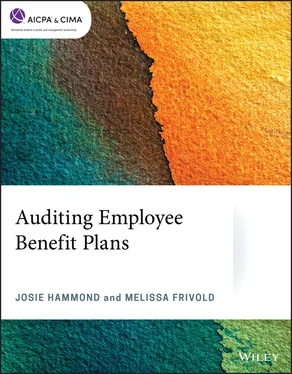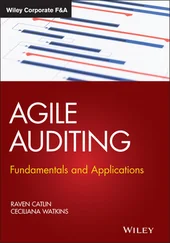The purpose of this course is to assist you in auditing employee benefit plans. Most employee benefit plan audits are required for compliance with the Employee Retirement Income Security Act of 1974 (ERISA). A critical step in any audit process is to gain an understanding of the entity subject to audit. This chapter outlines the basic types of plans, the roles of the parties involved in running those plans and the tax rules, which define the limits of their operation. Chapter 2will address applicable accounting and reporting standards, as well as recent developments in the employee benefit plan industry. Chapter 3will discuss reporting and audit requirements.
ERISA is the starting point for plan definition. ERISA contains four titles. Title I includes the general Department of Labor (DOL) responsibilities for plans. It includes reporting and disclosure (where the audit rules are located), funding, benefit accrual and vesting, fiduciary conduct, and enforcement. Title II is the tax law requirements for benefit plans. This includes nondiscrimination, funding, vesting, coverage, and so on. Title III deals with specific jurisdiction and enforcement procedures, which are beyond the scope of this course. Title IV deals with the plan termination insurance program for defined benefit pension plans (including single employer, multiple employer, and multiemployer).
Most of this chapter will be spent dealing with the operational framework of benefit plans. This is particularly necessary, as there has been a significant change in the kinds of employee benefit plans offered since ERISA passed. Through the mid-1980s to early 1990s, fully insured noncontributory medical and life plans, and defined benefit plans were typical employer-sponsored plans. However, economic instabilities, the spiraling cost of medical care, the shift to two-income families with the resulting desire of employees to pick their personal benefit package from what is offered by both employers and, finally, the tendency of employees to change jobs frequently have all contributed to significant changes in benefit plans. Today, an employer is more likely to provide a contributory self-funded medical plan via a cafeteria plan, voluntary supplemental life or disability coverage, and a defined contribution profit-sharing plan with an employee contributory 401(k)/403(b) feature. Only the fully insured group life plan has remained relatively intact over this time.
A plan is not just a document. One plan may have several separate documents. Several plans may be found within a single legal document. For purposes of this program, an arrangement is considered a plan if it has the following attributes:
Benefits
Beneficiaries or participants
Funding
Administrative system 1
Under ERISA, there are two broad categories of employee benefit plans: welfare and pension.
A plan of welfare benefits, by ERISA definition, comprises any one or more of the following benefits:
Medical, surgical, or hospital care
Sickness, accident, disability, death, or unemployment
Vacation
Apprenticeship or other training programs
Day care centers
Scholarship funds
Prepaid legal services
Any benefit described in Section 302(c) of the Labor Management Relations Act, 1947 (except pension)
ERISA provides for some other specific exemptions from all or part of ERISA, including the following:
Church and governmental plans
Certain payroll practices. Payroll practices are defined as various payments of compensation eitherin excess of normal pay for duties other than under ordinary circumstances, such as overtime pay, shift, holiday, and weekend premiums; oras normal compensation out of general assets for periods of time when the employee is physically or mentally unable to perform; oras normal compensation out of general assets for periods of time when the employee is physically or mentally able to perform, but on vacation, military or sabbatical leave, serving jury duty, or in training.
Other fringe benefits may include on-premises facilities, holiday gifts, employee discounts, hiring halls, remembrance funds, strike funds, industry advancement programs, and unfunded scholarship programs
Certain group or group-type insurance programs—such arrangements are frequently included with a cafeteria plan package. These plans are exempt ifno contributions are made by an employer or employee organization;participation is completely voluntary; andthe sole function of the employer or employee organization, without endorsement, is to permit the insurer to publicize the program, and to collect only administrative costs in connection with payroll deductions, services, or dues check-offs.
Unfunded or top-hat plans for a select group of management or highly compensated employees who are subject to ERISA but exempt from Form 5500 reporting and the related audit
The auditor needs to be familiar with these exemptions but should not be making the determination of whether a plan is or is not subject to ERISA, nor whether the plan is subject to audit. That determination is a complicated decision with sometimes unexpected and undesirable consequences that extend far beyond simply whether or not a Form 5500 or audit is required. The plan sponsor’s legal counsel should assist in determining which reporting requirements apply, if any, to a particular employee benefit plan.
Pension benefits are more easily defined in ERISA as a plan, fund, or program that provides retirement income to employees, or results in a deferral of income by employees for periods extending to the termination of covered employment or beyond.
Some pension plan exemptions from ERISA are severance pay plans, 2bonus programs, individual retirement accounts, gratuitous payments to pre-Act retirees, certain tax-sheltered annuities, and supplemental unemployment compensation plans.
As with welfare benefit plans, the auditor should not be making the decision whether a pension plan is subject to ERISA. The auditor needs to be aware that this is a complicated decision that affects many factors beyond the annual filing. Where the client seeks some assistance on this matter, the auditor may wish to direct the client to the listing of Advisory Opinions found on the website for the Employee Benefits Security Administration (EBSA). Many of these provide insight into when an arrangement is subject to ERISA.
1 ERISA divides employee benefit plans into which two categories?Defined contribution plans and defined benefit plans.Pension plans and welfare plans.Defined contribution plans and health and welfare plans.Profit sharing plans and 401(k) plans.
Plans as defined by GAAP
Defined contribution and defined benefit
These terms relate to how benefits are determined. Under a defined contribution plan, benefits are limited by the contributions to a participant’s accounts. Participant account balances may also be affected by investment experience, expenses, and forfeiture allocations, depending on plan design and funding.
A defined benefit plan does exactly that, defines the benefits; that is, the benefits can be determined by reference to the plan design. Sometimes benefits are determined according to a schedule of what will be reimbursed or paid directly to providers, as in medical plans; or developed based on a formula, including factors such as pay or years of service, as in defined benefit pension plans.
Neither of these plan types is required to be funded, by the nature of their design. However, ERISA requires that pension plans, whether defined benefit or defined contribution, be funded.
Читать дальше











